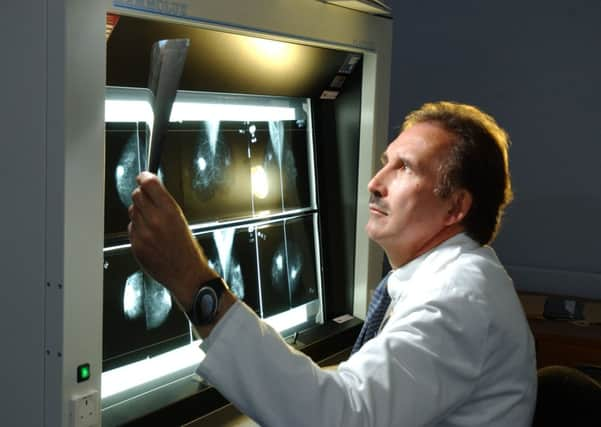Screening stacks the odds against cancer


Every year 4,500 women in Scotland are diagnosed with breast cancer. We know that the earlier a breast cancer is detected, the better the chance of successful treatment, yet, every year, 1,000 Scottish women die from the disease. We also know that breast cancer is most commonly found in older women. For this reason, women between the ages of 50 and 70 are invited to attend breast screening every three years for the simple fact that it has been shown to identify cancer at an early stage.
One woman who has experienced early identification through breast screening is Pat Wight. At the age of 63, Pat was diagnosed with breast cancer after a routine screening appointment. After two years of treatment she is now cancer-free. Pat believes that had she not been screened, her cancer would not have been detected and successfully treated.
Advertisement
Hide AdAdvertisement
Hide AdBreast screening may also find cancers that do not necessarily need treatment. These are termed “non-invasive”. This means there are cancer cells in the breast, but they are only in the milk ducts and have not spread further. For some women with non-invasive breast cancer, the cancer cells stay inside the ducts but for other women the cells will grow into the surrounding tissue in the future. The problem is doctors do not know which non-invasive cancers will develop further and which won’t, so treatment is offered to all women with this early form of the disease. This means there are some who may undergo a course of treatment for a breast cancer that was never going to become life-threatening.
This is known as “over-treatment”. You may have heard a lot about this over the past couple of years, including calls for women to have informed choice about whether to accept their screening appointment; that is, being aware of the all the benefits and risks of screening before making a decision.
In 2012, an independent review of the evidence for and against breast screening led to NHS Scotland revising the information given to women invited to attend. A working group reviewed the current invitation letter and accompanying information to ensure women received the facts necessary to make an informed choice. The working group involved charities, including Breakthrough Breast Cancer, offering constructive input. The result was a screening letter and leaflet that the working group regarded as a big improvement on the existing information, providing women with honest, impartial and balanced content.
So I was disappointed to read recent headlines and reports that the new information might scare women into not attending. On the contrary, I believe this is giving women just what had been called for – a balance between the pros and cons to inform their decision. It is designed to enlighten not frighten, to offer informed choice not misinformed fears, and it has our full support.
Breakthrough Breast Cancer believes screening saves lives, so we encourage women to attend. We recognise there are risks too and that women need to be able to choose what is right for them. Breakthrough has produced an interactive guide (at www.breastscreeningfacts.org) to explain the benefits and risks.
So, how do women get that important early diagnosis? We’ve already mentioned that attending routine screening is effective. But whether or not you go to screening, we encourage all women to be breast-aware; to know how their breasts look and feel normally and to regularly “TLC” – Touch, Look and Check – for changes and get anything unusual checked out by their GP. Most breast cancers are found by women themselves, which is why it’s so important.
There are also lifestyle changes women can make to reduce the risk of breast cancer developing in the first place. These include maintaining a healthy weight (particularly after the menopause), reducing alcohol intake and increasing physical activity. If you are worried about your breast cancer risk, visit your GP to discuss this or visit our website for more information.
Early diagnosis through screening and being breast-aware are important. So too is reducing the risk. Together, these can help stack the odds against breast cancer, the most common cancer amongst women in Scotland today.
• James Jopling is director for Scotland at Breakthrough Breast Cancer